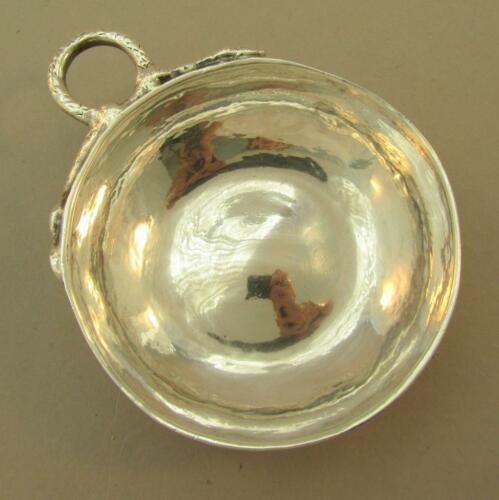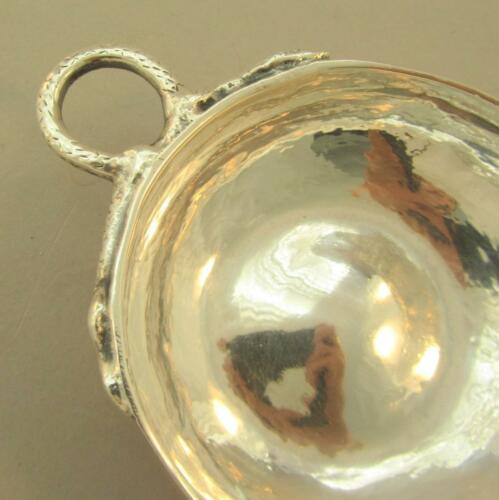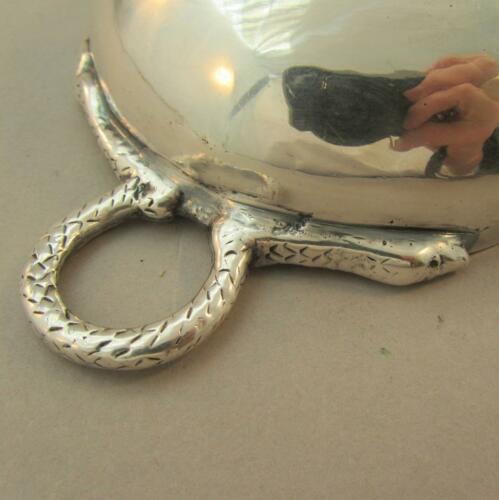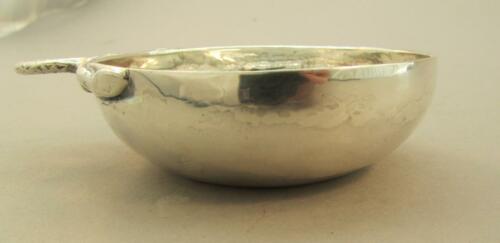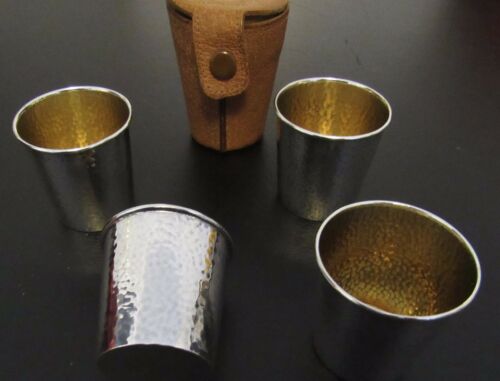-40%
Silver Wine taster tastevin Paris 1757-58 Jean Debrie
$ 395.47
- Description
- Size Guide
Description
4 ½” handle to opposite rim, 3 7/16” wide, 1 1/8” tall93 grams or 2.99 troy ounces.
This is an 18th century wine taster made in Paris by Jean Debrie, master in 1725 died 1758. There are only 3 marks. The crowned A is the Charge mark for Paris used Oct. 1756 to Nov. 1762. The crowned R is maison commune mark used July 1757 to July 1758. The third mark is the maker’s mark JDB for Jean Debrie.
The discharge mark is missing, probably due to a later repair. The taster, at one time, must have been ripped considerably on at least one side of the handle. There is solder, barely visible, that extends about 2.5 cm or one inch to the left of the handle, it also may extend about a half inch to the right of it. There is also a hairline, but open, crack about 4 mm long underneath the handle.
This is an absolutely correct 18th c. wine taster, although damaged. If you have any doubts please read on.
First as to the marks: 18th century France had a lot of “rules” about the production of silver, often the rules were breached. I wrote and article on the subject for Silver Magazine. A lot of “experts” say if any mark is missing, or looks a bit odd, or doesn’t fit the norm it must be fake. These “experts” are usually amateurs found contributing to on-line forums. Most “fakes” are actually Hanau German reproductions, that are most often not even made in the correct fashion. The marks are well documented and really shouldn’t fool anyone, except a beginner. Still they make up the majority of the fakes on the market, presumably offered by ignorant or dishonest dealers, or collectors. The second type of fakes were actually faked by silversmiths in the 19th c. most of these marks are well documented and shown by Helft in his books. The third type of fakes, especially wine tasters, are reproductions usually with later marks, that are mis-understood because of an 18th century coin, or an engraved, and spurious, 18th century date. These also shouldn’t fool anyone, but do. In over 40 years in the business I have seen only a handful of fakes made outside of these three types. I also wrote an article on this subject for an on-line silver collector’s site.
French 18th c. silversmiths often had two marks one for large works, another for small ones. These marks could wear out, and have to be replaced, sometimes the forms were also changed for a number of reasons. Jean Debrie was know to have used 3 marks, all similar, registered in 1725, 1738, and 1750. So to be sure this is by Debrie the connoisseur has to find photos of the third mark, and not just go by the drawings shown in most books. Luckily it was no problem finding examples of his work, he made a lot of tasters and goblets. Next to make sure it is right, it is really necessary to compare the Charge mark, not only with real examples but known fakes. It is correct too. Finally the same was done with the date letter. As to the missing discharge mark, probably a shell, I wouldn’t reject a piece missing it, but in this case it is actually understandable. The discharge mark on tasters was often on the left of the handle, right where the most solder is visible on this one. Although it is possible it was mixed in with the decoration on the handle and was worn enough to be invisible, it is far more likely it was simply covered by solder, in fact it may have contributed to the damage, as it might have been struck too hard and weakened the silver. I should also point out that the solder under the handle is really not noticeable. Solder is usually slightly more yellow than the surrounding silver, and pitting is often visible. This is the case on the left side. On the right side, there is probably a small bit, but it is difficult to differentiate it from some modest fire scale, which has probably come to the surface due to excessive polishing done at the time of the repair. The small rip, may be left over from the original damage, it shouldn’t really affect the display or use of the taster, as it just under the handle. Except for the location of the rip, the silver does not seem very thin, the original damage must have been caused by considerable force. The final proof that this is 18th c is the patina, the underside and the inside of the bottom looks like it should. I have never seen patina faked well enough to fool. It is evident that at some time the sides of the taster were over polished as the patina is not what one would expect on a 250 year old piece.
As to the value it is certainly worth more than the fakes on the market, and we priced it at the low end of real 18th c. tasters. I have seen many priced higher, with problems I would call more severe.
I should also state, I doubt that any of the problems with this one would be described by some sellers, as they are not particularly noticeable, except of course for the missing discharge mark.
Save time & money with
FREE Auctiva Image Hosting.
Auctiva,
The complete eBay Selling Solution.
Track Page Views With
Auctiva's FREE Counter
